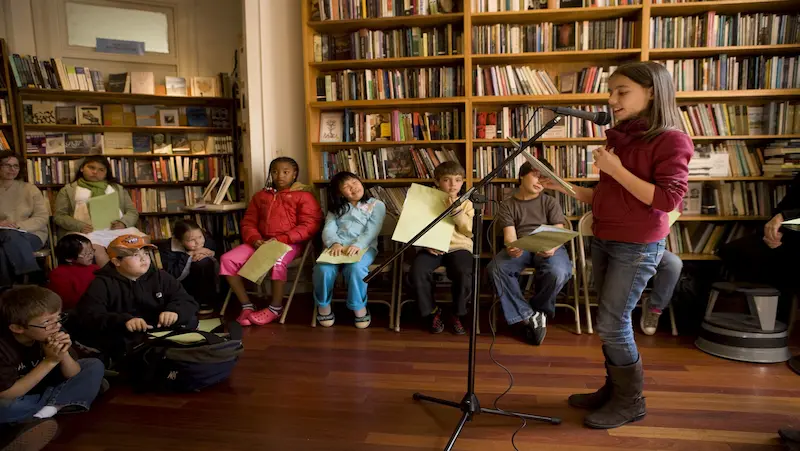English poems for kids play a vital role in fostering language development and nurturing a love for literature from a young age. The power of poetry lies in its ability to captivate children’s imagination, engage their senses, and stimulate their linguistic skills. Through rhythmic patterns, vivid imagery, and playful language, poems provide an ideal platform for children to explore the beauty of language while enhancing their overall communication skills.
In this modern age, where technology often dominates children’s leisure time, exposing them to poetry becomes increasingly crucial. The benefits of English poems extend far beyond mere entertainment; they serve as a powerful tool for language acquisition and development.
By engaging with poetry, children can expand their vocabulary, improve their phonemic awareness, enhance their cognitive abilities, and develop a deeper understanding of the nuances of language. One of the significant advantages of English poems is their rhythmic structure. The rhythmic patterns and rhyming words in poems create a memorable and melodic experience for children.
This rhythmic quality helps in building phonological awareness, assisting children in recognizing and manipulating the sounds of language. Through repetition and rhyme, children develop a sensitivity to syllables, phonetics, and patterns, which are essential foundations for effective reading and writing skills.
English poems for kids also promote emotional development and empathy. Poems often explore themes of friendship, love, nature, and self-discovery, allowing children to connect with the emotions and experiences expressed by the poets. Through the exploration of different perspectives and emotions, children learn to empathize with others and develop a deeper understanding of the human condition.
Table of contents
Age-Appropriate English Poems For Kids
Poetry has the remarkable ability to captivate young mind mapping for kids and spark their imagination. It serves as a beautiful medium to introduce children to the world of language, rhythm, and creativity. However, not all poems are suitable for every age group.
In this blog, we will explore age-appropriate poems and divide them into subsections for different age groups, from preschoolers to primary school children. Let’s embark on this delightful journey through the stages of childhood!

I. Preschoolers (Ages 3-5)
Preschoolers have boundless curiosity and an eagerness to learn. The poems in this section are simple, short, and filled with vivid imagery to engage their senses and foster their love for language. Here are a few examples:
“Five Little Ducks” by Anonymous:
This classic nursery rhyme teaching kids kindness counting skills while incorporating a repetitive structure that preschoolers enjoy. The lively rhythm and adorable animal characters make it a delightful choice.
“Rainbow Colors” by Unknown:
A poem that introduces colors using the beautiful imagery of a rainbow. It helps preschoolers identify and name different colors while creating a sense of wonder and joy.
“I’m a Little Teapot” by George Harold Sanders:
A playful poem that encourages physical movement and coordination. Preschoolers can enjoy acting out the motions of a teapot, promoting imaginative play.
II. Primary School Children (Ages 6-10)
As children progress into primary school, their language skills develop, and their understanding of the world expands. Poems for this age group can be slightly longer and may introduce more complex themes and concepts. Here are a few examples:
“The Owl and the Pussycat” by Edward Lear:
A whimsical poem that takes children on an enchanting adventure with delightful characters. It introduces elements of storytelling, rhyme, and imagination, stimulating their creativity.
“The Road Not Taken” by Robert Frost:
This timeless poem explores the concept of choices and encourages critical thinking. It introduces children to metaphorical language and invites them to contemplate the consequences of decisions.
“If I Were in Charge of the World” by Judith Viorst:
This a thought-provoking poem that empowers children to dream and imagine a better world. It encourages empathy, self-expression, and reflection on the qualities they value in their surroundings.
Making Learning Fun
Learning is often associated with books, lectures, and structured activities for kids, which can sometimes make the process feel monotonous and dull for students. However, incorporating elements of fun, such as gestures, actions, and props, can greatly enhance the learning experience.
By actively engaging students and tapping into their creativity and imagination, educators can create an environment that fosters enthusiasm, retention, and a genuine love for learning. In this blog, we will explore the power of gestures, actions, and props as effective tools to make learning an enjoyable adventure, with a particular focus on reciting poems.

The Magic of Gestures:
Gestures have the remarkable ability to bring words to life, making them more tangible and memorable. When reciting poems, encourage students to use their hands and body movements to illustrate key concepts or actions mentioned in the verses.
For example, while reciting a poem about a soaring bird, students can extend their arms and simulate the graceful flapping of wings. This physical engagement helps students connect with the content on a deeper level, enhancing their comprehension and retention.
Adding Actions for Active Learning:
Incorporating actions into the recitation of poems can transform the learning process into a dynamic and interactive experience. By assigning specific actions to certain words or phrases, educators can encourage students to actively participate and become part of the poem itself.
For instance, in a poem about a rainstorm, students can mimic the sound of raindrops by gently tapping their fingers on their desks or shoulders. These actions make the poem come alive, enabling students to absorb information in a multisensory manner while having fun.
Props: Props: The Perfect Companions for Poems:
Props can be fantastic companions in the realm of poetry recitation, as they provide visual and tactile stimulation. Integrating props into the learning environment not only captures students’ attention but also allows them to explore the concepts within the poems more vividly.
For instance, when reciting a poem about the ocean, students can hold seashells, toy boats, or blue fabrics to create a sensory connection to the topic. By involving props, educators create a tangible bridge between abstract ideas and students’ real-world experiences, making learning more relatable and enjoyable.
Fostering Creativity and Collaboration:
By encouraging students to incorporate gestures, actions, and props into their poetry recitations, educators foster creativity and collaboration among learners. Students can work together in groups, brainstorming and creating their own actions or props for specific poems.
This collaborative process not only strengthens their understanding of the content but also cultivates teamwork, communication, and problem-solving skills and leadership skills for kids. Moreover, when students have the freedom to express their creativity, they become active participants in their own learning journey, fostering a sense of ownership and empowerment.
Vocabulary and Pronunciation Enhancement
As parents, we all want our children to excel in language skills, including a rich vocabulary and accurate pronunciation. These fundamental aspects of communication not only contribute to academic success but also play a significant role in shaping their overall confidence.
One creative and effective way to enhance vocabulary and pronunciation skills in children is through the use of poems. Poems, with their rhythmic patterns and lyrical qualities, offer a delightful and engaging medium for learning. In this blog, we will explore how parents can leverage poems as tools to enhance their child’s vocabulary and pronunciation.

Building Vocabulary
Poems, with their diverse themes and rich imagery, provide a treasure trove of words for children to explore. Here’s how parents can use poems to build their child’s vocabulary:
a. Word Exploration: Select poems that introduce new words or evoke vivid imagery. Encourage your child to identify unfamiliar words and discuss their meanings. Look up definitions together and encourage the use of these new words in everyday conversations.
b. Contextual Understanding: Poems often provide context clues that aid in understanding new words. Help your child identify the context and decipher the meaning of unfamiliar words based on the poem’s theme, tone, or imagery. This practice develops their ability to derive meaning from context in other reading materials as well.
c. Word Associations: Poems can spark associations between words and concepts. Encourage your child to make connections between the words used in the poem and real-life experiences, emotions, or objects. This association strengthens their vocabulary retention and understanding.
d. Thematic Exploration: Explore poems centered around specific themes or subjects of interest to your child. This approach not only expands their vocabulary related to the theme but also fosters a love for learning by connecting with their interests.
Refining Pronunciation:
Poetry’s rhythmic and rhyming patterns make it an excellent tool for refining pronunciation. By engaging with poems, children develop a keen ear for sounds, rhythm, and pronunciation. Here’s how parents can utilize poems to refine their child’s pronunciation:
a. Repetition and Recitation: Encourage your child to recite poems aloud. The repetition of words, phrases, and verses allows them to practice proper pronunciation, enunciation, and stress on syllables. Gradually, they will develop a natural rhythm and intonation while speaking.
b. Mimicking Sounds: Poems often contain unique sounds, alliterations, and onomatopoeia. Encourage your child to imitate these sounds and identify the corresponding letters or phonetic patterns. This exercise enhances their phonetic awareness and refines their pronunciation skills.
c. Listening and Imitation: Expose your child to recorded recitations or performances of well-known poems. By listening to expert renditions, they learn proper pronunciation, pacing, and emphasis. Encourage them to imitate these recordings, thereby honing their own pronunciation skills.
d. Poetry Games: Engage in interactive poetry games with your child. Play games for kids that involve rhyming words or tongue twisters to challenge their pronunciation abilities. Such activities make learning fun and encourage them to experiment with different sounds and speech patterns.
Integration of English Poems into Daily Routine
Incorporating English poems into daily routines can be a fantastic way for parents to enhance their children’s language skills and foster a love for literature from an early age. By making poetry a part of their everyday lives, parents can create a nurturing environment that encourages creativity, vocabulary development, and a deeper understanding of language.
In this blog post, we will explore various ways parents can integrate English poems seamlessly into their daily routines, making learning a joyful and natural experience for their children.

Morning Rituals:
Start the day with a touch of poetry by introducing a morning ritual where you recite or read aloud a short English poem. Choose poems that are engaging, rhythmic, and age-appropriate for your child. By incorporating poetry into this routine, you set a positive tone for the day and expose your child to the beauty and power of language right from the start.
Mealtime Moments:
Use mealtime as an opportunity to engage your child in poetic conversations. Share simple, rhyming poems related to food, nature, or family themes, and discuss their meanings together. Encourage your child to ask questions, make connections, and even compose their own short poems. This not only enhances their language skills but also makes mealtime an interactive and enjoyable experience.
Bedtime Verses:
Create a cozy and soothing atmosphere before bedtime by reading or reciting calming English poems. Choose poems that inspire imagination, promote relaxation, or tell a gentle story. Bedtime verses not only help your child wind down but also develop their listening skills and expand their vocabulary. Encourage them to express their thoughts or emotions related to the poem, fostering their creativity and critical thinking.
Car Rides and Commutes:
Turn car rides or commutes into fun and educational moments by incorporating English poems. Keep a collection of age-appropriate epic books for kids or print out poems in advance. Encourage your child to read the poems out loud or take turns reciting lines. Engaging with poems during these everyday moments not only makes the journey more enjoyable but also helps improve their pronunciation and fluency.
Poem of the Week:
Designate a specific poem for each week and display it prominently in your home. Encourage your child to read it, recite it, or even write it out. Make it a family activity by discussing the themes, analyzing the language, and exploring any new vocabulary. As the week progresses, encourage your child to incorporate the poem into their everyday conversations, relating it to their experiences or observations.
Multimedia Exploration:
Leverage the power of technology by exploring multimedia resources related to English poems. Look for animated videos, audio recordings, or even interactive apps that bring poems to life. Watching and listening to poems accompanied by visuals can captivate your child’s attention and help them understand complex concepts or emotions portrayed in the poems.
To know more about what is robotics for kids and robotics programming for kids follow our page!
Conclusion
In conclusion, poetry has a unique ability to touch our hearts, stir our emotions, and inspire us to see the world from different perspectives. It is a powerful form of expression that connects people across time and cultures. As we come to the end of this discussion, we would like to invite you, the readers, to share your favorite poems or personal experiences related to poetry in the comments section below.
Whether it’s a poem that holds a special place in your heart, an encounter with a poet or a poetry event that left a lasting impression, or even your own poetic creations, I encourage you to take this opportunity to share and connect with fellow poetry enthusiasts. Your contribution could spark a conversation, offer inspiration, or introduce someone to a new poet or poem they’ve never encountered before.
By sharing our favorite poems or experiences, we create a vibrant community of individuals who appreciate the beauty and power of poetry. So, don’t hesitate to leave a comment and let us know what moves you, what stirs your soul, and what poetry means to you. Together, we can celebrate the magic of words and continue to foster a love for poetry in others.
Thank you for joining us on this poetic journey, and I look forward to reading your comments and discovering the rich tapestry of experiences and poems that you have to share.
Empower your child with the tools to innovate, manage money wisely, and shape the digital world. Join the BrightChamps family today and pave the way for a future brimming with possibilities!
Frequently Asked Questions
A1: Teaching English poems to kids enhances their language skills, boosts creativity, develops critical thinking, and improves their ability to express emotions and ideas.
A2: You can make learning English poems enjoyable by using gestures, props, and visual aids, encouraging dramatic interpretations, organizing poetry recitals or competitions, and incorporating multimedia resources like videos or interactive apps.
A3: Yes, there are age-appropriate poems available for various age groups. You can find nursery rhymes and shorter poems for younger children, while older kids can engage with longer narratives or more complex themes.
A4: Yes, teaching English poems helps expand vocabulary and improves pronunciation skills. Encourage your child to read aloud, discuss unfamiliar words, and explore the meaning of different phrases to enhance language development.
A5: You can incorporate poems into your daily routine by setting aside dedicated time for reading and reciting poems together, creating a poetry corner in your home, using poems as bedtime stories, or integrating them into activities like arts and crafts or nature walks.


 We are an army of educators and passionate learners from BrightChamps family, committed to providing free learning resources to kids, parents & students.
We are an army of educators and passionate learners from BrightChamps family, committed to providing free learning resources to kids, parents & students.








